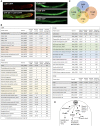Local calcium signal transmission in mycelial network exhibits decentralized stress responses
- PMID: 36896124
- PMCID: PMC9991499
- DOI: 10.1093/pnasnexus/pgad012
Local calcium signal transmission in mycelial network exhibits decentralized stress responses
Abstract
Many fungi live as mycelia, which are networks of hyphae. Mycelial networks are suited for the widespread distribution of nutrients and water. The logistical capabilities are critical for the extension of fungal survival areas, nutrient cycling in ecosystems, mycorrhizal symbioses, and virulence. In addition, signal transduction in mycelial networks is predicted to be vital for mycelial function and robustness. A lot of cell biological studies have elucidated protein and membrane trafficking and signal transduction in fungal hyphae; however, there are no reports visualizing signal transduction in mycelia. This paper, by using the fluorescent Ca2+ biosensor, visualized for the first time how calcium signaling is conducted inside the mycelial network in response to localized stimuli in the model fungus Aspergillus nidulans. The wavy propagation of the calcium signal inside the mycelium or the signal blinking in the hyphae varies depending on the type of stress and proximity to the stress. The signals, however, only extended around 1,500 μm, suggesting that the mycelium has a localized response. The mycelium showed growth delay only in the stressed areas. Local stress caused arrest and resumption of mycelial growth through reorganization of the actin cytoskeleton and membrane trafficking. To elucidate the downstream of calcium signaling, calmodulin, and calmodulin-dependent protein kinases, the principal intracellular Ca2+ receptors were immunoprecipitated and their downstream targets were identified by mass spectrometry analyses. Our data provide evidence that the mycelial network, which lacks a brain or nervous system, exhibits decentralized response through locally activated calcium signaling in response to local stress.
Keywords: calcium signal; calmodulin; calmodulin-dependent kinases; fungi; mycelia.
© The Author(s) 2023. Published by Oxford University Press on behalf of National Academy of Sciences.
Figures




Similar articles
-
Foraging strategies of fungal mycelial networks: responses to quantity and distance of new resources.Front Cell Dev Biol. 2023 Aug 24;11:1244673. doi: 10.3389/fcell.2023.1244673. eCollection 2023. Front Cell Dev Biol. 2023. PMID: 37691819 Free PMC article.
-
Bidirectional Propagation of Signals and Nutrients in Fungal Networks via Specialized Hyphae.Curr Biol. 2019 Jan 21;29(2):217-228.e4. doi: 10.1016/j.cub.2018.11.058. Epub 2019 Jan 3. Curr Biol. 2019. PMID: 30612903
-
Fungal mycelia and bacterial thiamine establish a mutualistic growth mechanism.Life Sci Alliance. 2020 Sep 22;3(12):e202000878. doi: 10.26508/lsa.202000878. Print 2020 Dec. Life Sci Alliance. 2020. PMID: 32962971 Free PMC article.
-
Calcium decoders and their targets: The holy alliance that regulate cellular responses in stress signaling.Adv Protein Chem Struct Biol. 2023;134:371-439. doi: 10.1016/bs.apcsb.2022.11.001. Epub 2023 Jan 31. Adv Protein Chem Struct Biol. 2023. PMID: 36858741 Review.
-
Ectomycorrhizal fungi: exploring the mycelial frontier.FEMS Microbiol Rev. 2007 Jul;31(4):388-406. doi: 10.1111/j.1574-6976.2007.00073.x. Epub 2007 Apr 27. FEMS Microbiol Rev. 2007. PMID: 17466031 Review.
Cited by
-
Emergence of synchronized growth oscillations in filamentous fungi.J R Soc Interface. 2024 Oct;21(219):20240574. doi: 10.1098/rsif.2024.0574. Epub 2024 Oct 30. J R Soc Interface. 2024. PMID: 39471871 Free PMC article.
-
Harnessing Fungi Signaling in Living Composites.Glob Chall. 2024 Jul 12;8(8):2400104. doi: 10.1002/gch2.202400104. eCollection 2024 Aug. Glob Chall. 2024. PMID: 39469481 Free PMC article.
-
Foraging strategies of fungal mycelial networks: responses to quantity and distance of new resources.Front Cell Dev Biol. 2023 Aug 24;11:1244673. doi: 10.3389/fcell.2023.1244673. eCollection 2023. Front Cell Dev Biol. 2023. PMID: 37691819 Free PMC article.
-
Electrical signaling in fungi: past and present challenges.FEMS Microbiol Rev. 2025 Jan 14;49:fuaf009. doi: 10.1093/femsre/fuaf009. FEMS Microbiol Rev. 2025. PMID: 40118505 Free PMC article. Review.
References
-
- Heaton L, et al. . 2012. Analysis of fungal networks. Fung Biol Rev. 26:12–29.
LinkOut - more resources
Full Text Sources
Miscellaneous

